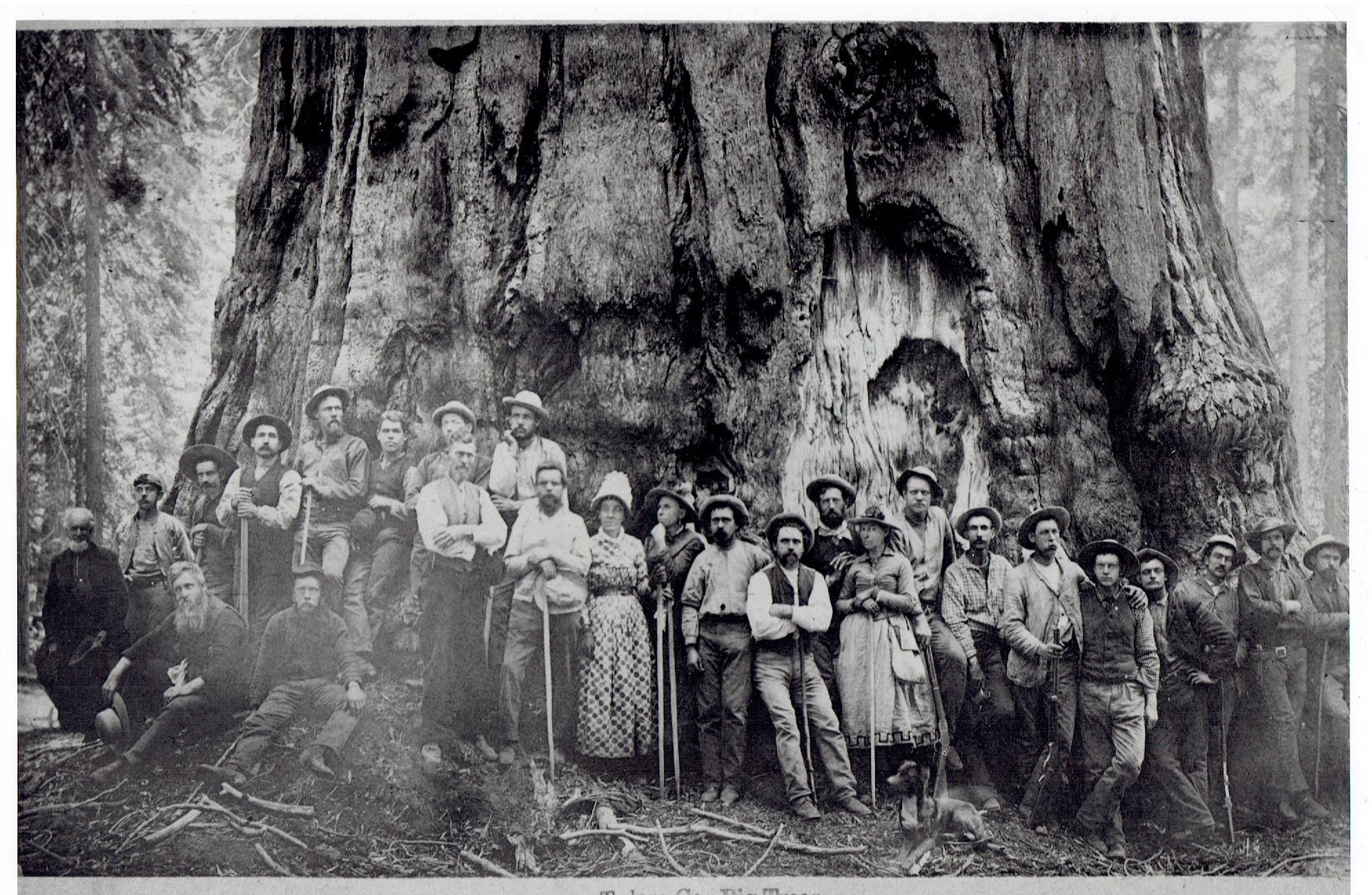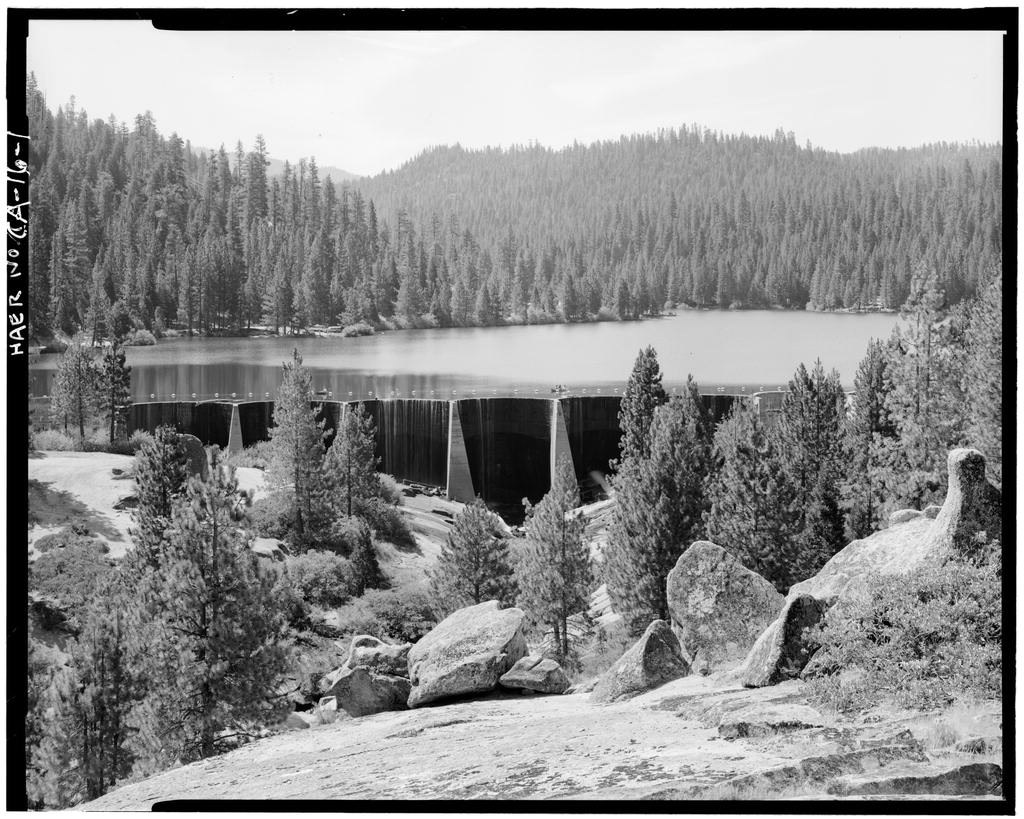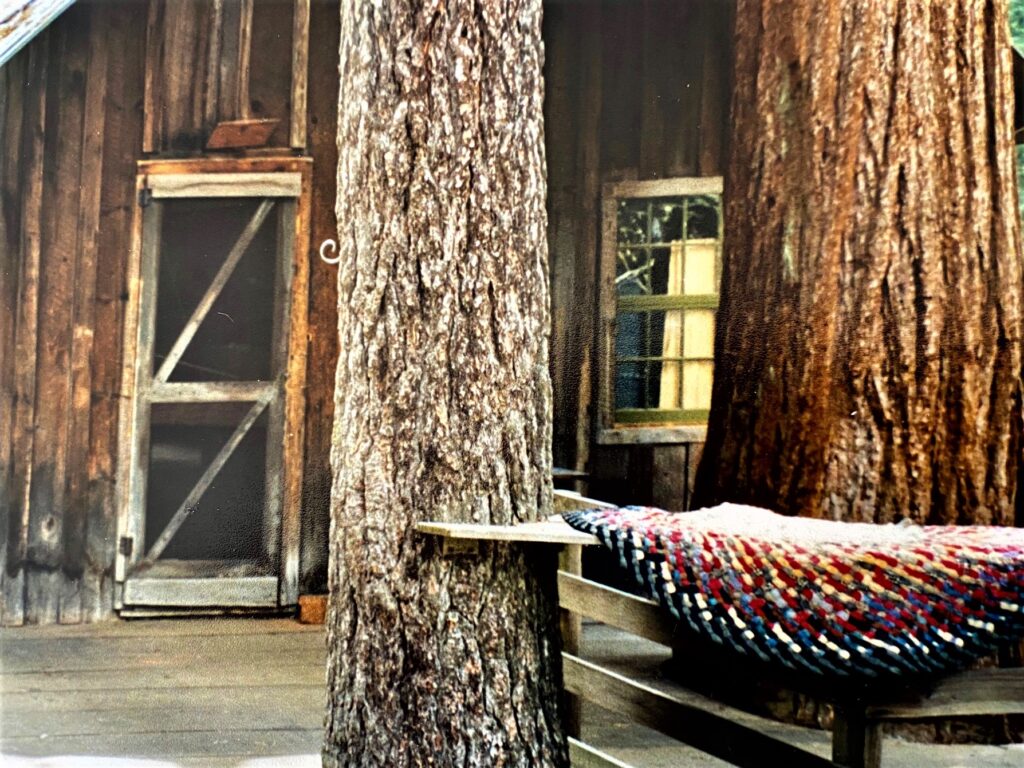
A History of the Kaweah Colony
Tag: logging

Since the dam that created Hume Lake was built over a century ago, there have been some quick fixes and minor repairs. But the improvements recently accomplished are the most extensive to date and are expected to last another 50 to 100 years.
16 May 2016, The Kaweah Commonwealth

Direct descendant of a dam built to create a log holding pond in 1908, the dam that holds Hume Lake has undergone some quick fixes and minor repairs over the last 100 years. But the improvements accomplished in 2016 are the most extensive to date and are expected to last another 50 to 100 years.
In October 2015, after the area was determined to be safe from the encroaching Rough Fire and the reservoir’s water was no longer needed for firefighting efforts, Hume Lake was drained, scaffolding erected, and work began.
After significant grouting in all the cracks and crevices where some seepage was occurring, a Carpi dam lining system was installed. This is a waterproofing geomembrane lining that was installed on the upstream side of the Hume Lake dam and restored watertightness to the entire face.
“It’s a phenomenal system,” said Teresa Benson, Hume Lake district ranger. “We ended up with a complete lining of the former concrete dam.”
The project was completed in March and the lake was refilled. The total cost was about $3 million.
This coming fall the lake will have to be drained one more time for a scheduled maintenance project.
“But it won’t be for as long this time,” said Teresa.
History of Hume Lake
Construction on the dam began in June 1908 when the Hume-Bennett Lumber Company created Hume Lake as an 87-acre log-holding pond. This area of what has been Sequoia National Forest since July 1908 was formerly the site of extensive logging operations.
After working their way through Converse Basin, where they felled every giant sequoia except for one, the lumberers were looking for new timber stands to harvest. They settled on trees to the east of Converse Basin and built a large sawmill complex.
Working dawn to dusk, seven days a week, crews finished building the dam in 114 days. The cost of construction was $46,541, and the finished dam was 667 feet in length, 61 feet high, and contained eight miles of steel cable reinforcing 2,201 cubic yards of concrete.
The Hume Lake dam was the first concrete reinforced multi-arch dam to be built in the United States. It consists of 12 arches with the upstream faces sloped so water pressure exerted downward keeps the dam stable.
The reservoir provided a year-round water source for the flume that transported via gravity the lumber to Sanger in the San Joaquin Valley below.
Concurrently, work was occurring on a three-story mill complex located below the dam. By 1910, the area included two huge drying kilns, a boiler house, powerhouse, and foundry. The adjacent community had a housing complex, dining hall, post office, and hospital.
And although the logging activity was intense, the expenses of operation and maintenance were high. The mill had a difficult time making ends meet.
On April 8, 1935, the U.S. Forest Service purchased Hume Lake, Converse Basin, and surrounding lands totaling more than 20,000 acres for $319,276.75.
Today, Hume Lake provides water for the nearby campground, privately held cabins, Christian camps, fire suppression, and recreation, including fishing, swimming, and non-motorized boating.

Grace Alles spent many summers at the family cabin at Atwell Mill. From her cabin, Grace could signal with lights to her sister Rose, who for some years was stationed at the Cahoon Rock Fire Lookout near Hockett Meadow, about 10 air miles away.
By Sarah Elliott, 3 September 1999, Kaweah Commonwealth
The Alles cabin is one of many historic remnants in the magical Mineral King area of Sequoia National Park that gives visitors a glimpse of late 19th and early 20th century life, a time that is so different, so far removed from today. The board-and-batten cabin, built in 1901, has been open to the public on Sunday during the past two summers.
The cabin is located 19 miles up the Mineral King Road from Hwy. 198 in Three Rivers (just before the Atwell Mill Campground) and 4.5 miles before the Mineral King Ranger Station. This Sunday of the Labor Day weekend marks the last time the cabin will be open to the public during the 1999 season.
Although there’s not much to see in the 600-square-foot dwelling, those with imagination and a love of history and the Sierra are transported to a time when the summer residence was a cozy, comfortable home for Philip Alles (pronounced Alice), his wife, Grace Mullenix Alles, and their two children, Rena and Oscar.
Docents, including Milton and Carol Savage and Jim and Jeanette Barton of Three Rivers, have worked tirelessly this summer to contribute to the upkeep of the cabin and restore the living quarters back to how the cabin by the Mineral King Road looked when Grace was in residence. The only thing that could keep Grace from the cabin every the summer was her death in 1981.
This summer (1999), with the help of National Park Service staff at Ash Mountain, a wood stove was delivered to the Alles cabin, a near-replica of the one Grace prepared meals on for her family, many guests, and sawmill workers for so many years.
Family ties
Philip and Grace Alles‘s daughter, Rena, was born at the family cabin in 1907. Rena married Fred Ogilvie and lived at the junction of South Fork and Old Three Rivers drives, near her parents’ home.
After living her entire life in Three Rivers, Rena moved a few years ago to the Bay Area to be near her daughter, Alice Noreen Ogilvie Schwartz. Bud and Dorothy Stuart of Three Rivers were visitors in the Alles cabin on a recent Sunday. Shirley Devol, who has a cabin in Mineral King, was the hostess that day and had a wonderful time listening to the couple’s reminiscences and taking notes.
Bud and Dorothy were married June 3, 1944, and honeymooned at the Alles cabin. The Stuarts became part of the family when Bud’s sister married Phil and Grace’s son, Oscar.
Hal Boley was another recent visitor. He passed by on his way to Hockett Meadow with his son, Tanner (a fifth-generation Alles), and Tom and Isaac Warner for a Boy Scout outing. Hal, too, has many memories of “Aunt Grace’s” cabin, and remembered the White wood stove and the cooler, accessible from inside the cabin but with the back side extending over the deck, covered with wet burlap bags for insulation, in place of the window that is now there.
Hal is the grandson of John Alles (1876-1957) and Rebecca Epperson Alles. John was Conrad and Christina Alles’s seventh child of 10 and brother to Phil Alles. He and Rebecca had three daughters — Thelma, Dorothy, and Lois.
Dorothy is Hal’s mother and Thelma, who has lived in Three Rivers much of her life, is matriarch of the Crain clan.
Hal’s new granddaughter, Savannah, is the sixth generation of the Alles family to reside in Three Rivers. Thelma’s granddaughter, Holly Crain- Peltzer, who also lives in Three Rivers, is a fifth-generation Alles.
Mullenix and his mill
Grace Alles has ties to the Atwell Mill area of Mineral King that began when her father, lsham “Doc” Mullenix, a Three Rivers pioneer, built the mill, which opened in 1873. It is no coincidence that this is the same year of the silver rush in Mineral King, and three mills were built in the vicinity to provide lumber to brace the mines and build dwellings.
The mill never proved profitable due to the same reasons mining in Mineral King could never pay. The location was too remote and the method of obtaining the product — in the mill’s case, giant sequoias — proved too difficult to cut. But Grace spent her childhood summers in this high mountain industrial environment, even receiving some of her schooling there.
In 1886, lsham sold his mill to A.J. Atwell, a retired judge from Visalia. Atwell also built cabins and a camp to help make his investment more profitable.
In 1891, Atwell leased the mill to the Kaweah Cooperative Colony, the utopian group headquartered on the upper North Fork in Three Rivers that had previously set their sights on the Giant Forest for its promise of timber. They were thwarted in those efforts in 1890 by the creation of Sequoia National Park.
In 1897, Mount Whitney Power Company leased Atwell’s Mill. The company felled giant sequoias to create more than one million board feet of lumber, which was used to build the flume from Oak Grove to Hammond near Three Rivers, over 30,000 feet in length (5.7 miles).
Most of the sequoia stumps at Atwell Mill that line the Mineral King Road and encompass the present-day campground are a result of this massive effort that, in less than one year, built the flume and the first hydroelectric station in Three Rivers.
In 1902, Judge Atwell sold the mill to Henry Alles, the eldest son of Conrad and Christina Alles and Grace Mullenix Alles’s brother-in-law. Henry was the first of the Alles family to emigrate to Three Rivers, convincing his parents and nine siblings to follow. They homesteaded land in 1885 on the South Fork of the Kaweah River.
Henry was born in 1866 and died in Three Rivers in 1940. Prior to owning the mill, he was the Mineral King stage driver, hauling guests, freight, and mail to and from the alpine valley.

A small village had grown up around the mill site. Phil and Grace Alles moved into their Atwell Mill summer cabin in 1901, directly up the slope from the operating sawmill.
addition to working with his brothers at the mill, Phil Alles began another business in 1917. He operated an “auto stage,” which left Visalia every Monday, Wednesday, and Friday at 1 p.m., stopped for the night at Lake Canyon, built by the Grunigen family in the 1890s, and arrived in Mineral King at 11 a.m. the following day.
He would spend part of Tuesdays, Thursdays, and Saturdays, and all day Sunday with his family at the cabin before his return trip to the sweltering San Joaquin Valley for his next fares.
In 1920, the final sale of the mill occurred. It was purchased by a Seattle resident, a representative of the National Geographic Society, who donated the property to the National Park Service.
The mill still operated for a decade more, off and on, to process some of the timber that was felled during its heyday. The Civilian Conservation Corps dismantled and removed the mill about 1939, leaving a part of the iron steam engine, which now commemorates the former site of the mill, located at the edge of the meadow about 500 yards below the Alles cabin.
The Alles name is no longer heard much around Three Rivers. Of the 10 children of Conrad and Christina Alles, all raised and educated in Three Rivers, there were six boys and four girls.
Three of the sons — Henry, Conrad, and Adam — never married. Phil and Grace Alles had one son, Oscar, the only male to carry on the Alles name. Oscar and his wife (Bud Stuart’s sister) had one daughter together.
The Mineral King Road was realigned later from where it used to pass by the mill to its present location within a few feet of the front door of the Alles cabin. Upon Grace’s death, the cabin reverted full ownership to the Park Service, and the little cabin in the middle of the road is what’s left of a fledgling town and business venture in the Mineral King wonderland of 100 years ago.